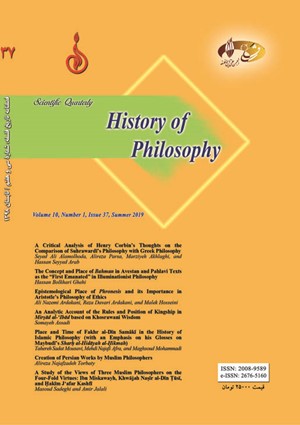Survey of Fakhr Al Din Sammki’s paraphrase on Meibodi’s commentary of Hidayat al Hikmah
Subject Areas : Etymology of philosophical termsTaherehsadat mousavi 1 , mahdi najafi afra 2 * , Maghsoud Mohammadi 3
1 -
2 -
3 - Islamic Azad University
Keywords: Fakhr al-Dīn Samākī glosses on Sharḥ al-hidāyah al-ḥikmah finitude of things sollemī (stepwise) argument ,
Abstract :
A necessary research activity in each period is the revival of the works of thinkers and philosophers who have played an essential role in the history of the development and advancement of Islamic culture and teachings but have remained unknown to the world. Fakhr al-Dīn Samākī, known as Muḥaqqiq Fakhrī, is one of these philosophers who lived in the 10th century (AH). He was the student of Ghiyāth al-Dīn Manṣūr Dashtakī. He wrote some important works such as Glosses on Qūshchī’s Sharḥ-i tajrīd and Glosses on Maybudī’s Sharḥ al-hidāyah al-ḥikmah. Athīr al-Dīn Abharī’s Hidāyah al-ḥikmah consists of three chapters on logic, physics, and theology. Maybudī commented on its two chapters of physics and theology, and Samākī wrote glosses only on the first and second sections of the three sections of the chapter on physics of Maybudī’s Sharḥ al-hidāyah al-ḥikmah. Unlike Ibn Sīnā and Suhrawardī, Samākī did not found a specific school of philosophy; however, he managed to play a significant role as a mediator in the development of philosophical thought in general and turn into a source of inspiration for Mullā Ṣadrā in developing his Transcendent Philosophy. He did so through presenting some accurate critiques, conducting thorough investigations, and expressing specific and innovative views regarding certain topics discussed by mutikallimūn, Peripatetic philosophers, Illuminationists, and gnostics within the framework of some of his dependent and independent (commentaries and glosses) works. Among such views, reference can be made to his different interpretation of sollemī (stepwise) argument and the development of three new arguments on demonstrating the finitude of things, which have been discussed in this paper.
ابنسینا (1404ق) الشفاء، الطبيعيات، تصحیح سعید زائد، قم: كتابخانة آیتالله مرعشی نجفی.
الطهرانی (آغابزرگ)، محمدحسن (1365) الذريعة الی تصانیف الشيعة، تهران: چاپخانه بانک ملی ایران.
انوشه، حسن؛ حائری قزوینی، سیدمهدی؛ زریاب خویی، عباس؛ مشایخ فریدنی، محمدحسین؛ رجاوند، پرویز (1360) دائرة المعارف تشیع، جلد9، تهران.
بهاردوست، علیرضا (1388) «تفسیر آية الکرسی میر فخرالدین حسین حسینی استرآبادی»، مجله آفاق نور، شمارة 9، 448ـ395.
تبریزی، علی بن موسی ثقه الاسلام (1433ق) مرآة الکتب، قم: كتابخانة آیتالله مرعشی نجفی.
ترکمان، اسکندربیک (1382) تاریخ عالم آرای عباسی، زیر نظر ایرج افشار، جلد1، تهران: امیرکبیر.
ثبوت، اکبر (1377) «هداية الحکمة و شروح آن»، خرد جاویدان (جشننامۀ سیدجلالالدین آشتیانی)، بکوشش علی اصغر محمدخانی و حسن سید عرب، تهران: نشر فروزان روز.
جوانمردی ادیب، علیرضا (1397) تصحیح انتقادی شرح هداية الحکمة قاضی کمالالدین حسین بن معین الدین میبدی، رسالة دکتری دانشکده ادبیات و علوم انسانی، دانشگاه آزاد اسلامی، واحد تهران مرکزی.
حسینی، سیداحمد (1371) فهرست نسخههای خطی کتابخانه عمومی حضرت آیت الله مرعشی نجفی، زیرنظر سیدمحمود مرعشی نجفی، قم: کتابخانه عمومی حضرت آیتالله مرعشی نجفی.
درایتی، مصطفی (بیتا) فهرستواره دستنوشتههای ایران (دنا)، مشهد: مؤسسة فرهنگی پژوهشی الجواد.
سیدحسینزاده، هدی (1394) تاریخ فراموش شدۀ ایران در دورۀ سلطان یعقوب آققویونلو، تهران: نشر تاریخ ایران.
طوسی، خواجه نصیرالدین (1375) شرح الاشارات و التنبیهات، قم: نشر البلاغه.
فرهنگستان علوم جمهوری اسلامی (1385)، جستاری در آراء و افکار میرداماد و میرفندرسکی، مجموعه مقالات و گفتارها، تهران: فرهنگستان علوم جمهوری اسلامی.
فیاض انوش، ابوالحسن (1389) «میرحسین میبدی (مقتول 911 ق) یک بازشناسی تاریخی»، مجله پژوهشهای تاریخی، دانشکدۀ ادبیات و علوم انسانی اصفهان، سال2، شماره3 (پیاپی 7).
قمی، عباس (1368) الکنی و الالقاب، جلد3، طهران: مکتب الصدر.
ملاصدرا (1393) شرح هداية الأثیرية، تصحیح مقصود محمدی، تهران: بنیاد حکمت اسلامي صدرا.

